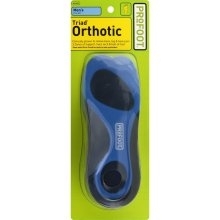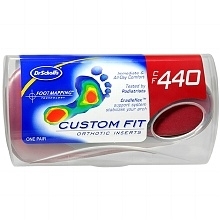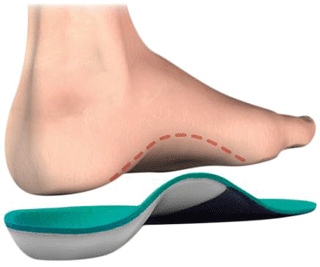An orthotic is an insert that fits inside a shoe and is designed to decrease abnormal foot motion, realign the foot, restore balance and eliminate or reduce foot pain. Orthotics generally come two ways, customized by an orthopaedist or podiatrist to fit your foot and meet your physical needs or, over-the counter, trim to fit.


Today, you can find orthotics in the drug store and the grocery aisle. They come in multiple sizes, designed for men or women, walking or sports, and cost about $30. Custom orthotics run $400-$600 and are not always covered by insurance. So, why go through the hassle and expense of seeing a doctor to get custom orthotics made instead of picking some up at your local Target? For one thing, you could do more harm than good.
The Challenge
“When the average person picks an orthotic shoe insert off the shelf, they risk causing more harm, warns Dr. Richard Hayes, a Board Certified Ankle & Foot specialist at Great Basin Orthopaedics in Reno, Nevada. “It is difficult for the average person to determine the cause of their pain or discomfort.”
Orthotic devices may be recommended for several reasons, including:
- aligning and supporting the foot or ankle
- preventing, correcting or accommodating foot deformities
- improving the overall function of the foot or ankle
People risk worsening their symptoms because the orthotic addresses something unrelated to the cause of their problem. If they select the wrong type of device, they could change the mechanics of their gait and cause problems instead of curing them.
Over-the-counter orthotics can serve the needs of some people adequately, particularly when combined with a stretching and exercise program. The trick is to understand who will benefit. An over-the-counter orthotic made of hard plastic polymer will provide more support than the typical soft shoe insole. Some brands even offer a semi-custom fit with an orthotic you can mold yourself after heating them in an oven before standing on them.
Diagnosis Chart:
Diagnosis Recommended Orthotic Device
Bunions and/or bunionettes Shoes with a wide toe box; soft, seamless uppers, stretchy shoes; "bunion shield" type pad
Corns and calluses If located on or between the toes, a toe separator may be helpful
Cavus foot (rigid high arch) Soft orthotic cushions to distribute pressures evenly
Flatfoot (adult) No device needed if there are no symptoms or pain - if there is pain or aching, a semirigid insert or long arch pad, inner heel wedge or extended heel counter may help
Flatfoot (child) No special orthotic device or shoe treatment is indicated, most infants have flat feet and 97 percent will grow out of it
Stiff big toe (hallux rigidus) Full-length prefabricated stiff insert, Morton extension inlay, or rocker bottom sole
Hammer toe or claw toe Shoes with a wide or deep toe box to accommodate the deformity; toe crest
Forefoot pain (metatarsalgia) Wide shoes, pads or bars under the bones of the forefoot (metatarsals)
Limb length deformity Custom-made full-contact orthosis
Morton neuroma Shoes with a wide toe box, metatarsal pad positioned over the neuroma
Neuropathic ulceration Full-contact cushioned orthosis, extra-deep or custom shoes, rocker bottom sole to reduce pressure on foot
(such as with diabetes)
(such as with diabetes)
Plantar fasciitis Prefabricated heel insert made of silicone, rubber or felt
(heel pain or heel spur)
(heel pain or heel spur)
Runner's painful knee Full-length, soft, prefabricated sport orthotic inlay to reduce stress and turning inward of the foot (pronation; flatfoot)
Courtesy American Orthopaedic Foot and Ankle Society

What You Get
The reason there is such a difference in price has to do with the customization and materials used when making the orthotics. The quality and durability of the materials, coupled with the custom molding process, contribute to the expense of custom orthotics. They cost more, but last longer and can be more effective.
If you suffer from chronic foot, heel, knee or toe pain that you suspect is related to your feet and how they are supported as you walk and run, see a specialist. The answer may be a $40 orthotic from Walgreens, a custom orthotic, or some simple stretching. When your health and comfort are in question, it pays to get an expert opinion.
Article sources
Chicago Tribune website, “Are over-the-counter orthotics a good idea?,” http://articles.chicagotribune.com/2011-03-30/a-z/sc-health-0330-orthoti...
American Academy of Orthopaedic Surgeons website, “Orthoitcs,” http://orthoinfo.aaos.org/topic.cfm?topic=A00172
Foot Education website, “Prefabricated (Over-the-Counter) Orthotics versus Custom Orthotics,” http://www.footeducation.com/prefabricated-over-the-counter-orthotics-ve...